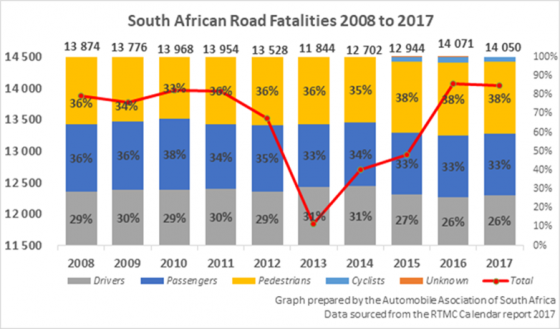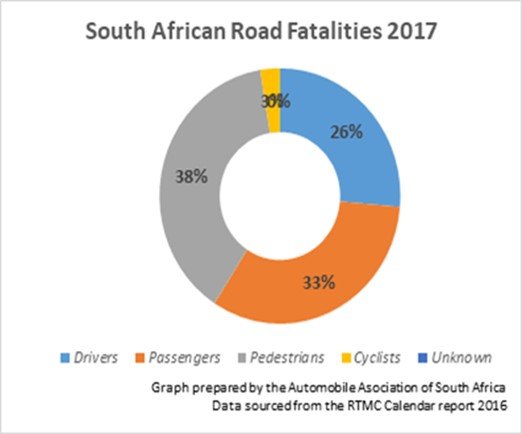
The annual road fatality statistics for 2017, made available by the Road Traffic Management Corporation (RTMC) on their website on Friday (SUBS: 20 April), is another indication of the need for urgent road safety intervention on South Africa’s roads. The statistics show the situation on the country’s roads is worsening, despite numerous safety campaigns by government and non-governmental organisations.
According to the statistics, 14050 people died in road crashes on South African roads in 2017. This is marginally lower than the 14071 people who died in road crashes in 2016 but still higher than any year from 2008 to 2015
It is also important to note that the preliminary Easter road fatality statistics – released earlier this month by Transport Minister Blade Nzimande – are 14% up over the same period last year. These figures, which are likely to climb, already do not bode well for the overall national road safety picture for 2018.
Seen against the backdrop of the fatality statistics the past ten years (from 2008) these numbers prove that current road safety initiatives are simply not working. Since then, almost 135 000 people died in road crashes in South Africa. This is a shocking number which, without urgent intervention, genuine commitment from all role-players, and a complete change in the attitude of all road users, will never significantly decrease.
It is noted that the ‘stabilising’ of the fatality rate at just over 14000 deaths per annum is unacceptable, and should be seen as a national crisis. A reversal of this can only be achieved through the implementation of several key plans. A key focus must be on pedestrians. Measures in this regard should include:
- Creating a safer environment for pedestrians to commute, especially on busy roads,
- Extensive nationwide pedestrian education campaigns,
- An increase in reliable, safe public transport,
- A swifter introduction of crash avoidance technology in vehicles, and,
- Encouraging employers to consider the wellness of employees, especially in relation to their commutes to and from work, through:
- Ensuring employees who walk to work are visible at all times, either through improving uniforms to make them more visible, or making the use of high visibility sashes, vests or jackets compulsory,
- Ensuring the safety of vehicles in fleets (or pool vehicles) and delivery bikes, and,Ongoing internal road safety education to staff.
Reducing pedestrian fatalities by half will bring down the national figures by almost 20% (around 2700 lives), a significant drop which will provide an immediate impact to reducing national fatality statistics.
It is also necessary for road users – pedestrians, cyclists and motorists – to realise that government can do only so much to improve road safety and reduce the number of crashes and fatalities on the roads.
Unfortunately too many South Africans have an extremely bad attitude towards safe road use, and all the education and enforcement in the world will not stop those intent on playing by their own rules. Without a change of attitude among road users – and, importantly, a respect for the law - efforts to decrease fatalities and crashes by a noticeable margin will fall flat.



